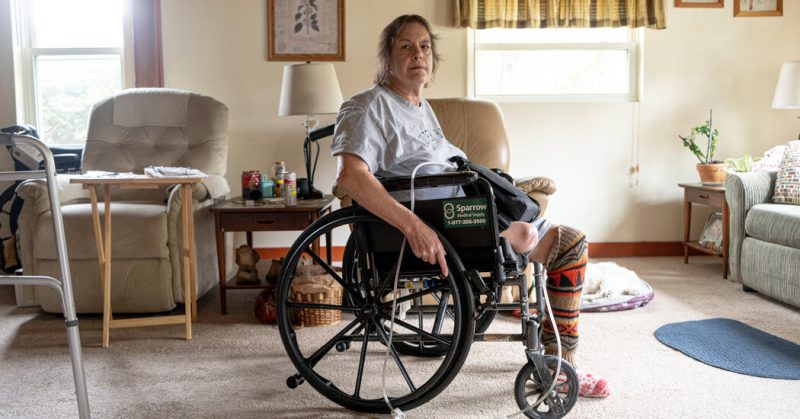Opinion | Are Doctors Doing Risky, Unnecessary Procedures?

To the Editor:
Re “Patients Lost Limbs as Doctors and Health Care Giants Prospered” (“Operating Profits” series, front page, July 16):
A small group of physicians has made millions performing unnecessary or incompetent stents and atherectomy procedures on patients with peripheral vascular disease — the narrowing or blockage of arteries carrying blood to the legs — when medical therapy may be better.
When these invasive procedures fail, the physicians and hospitals still gain hefty reimbursement, and the patient may lose a leg by amputation.
As a vascular surgeon for over four decades, I have witnessed this overuse of procedures and have known that manufacturers pay millions of “consulting” fees to some physicians who overuse stents and atherectomy devices.
How can we protect the needs of the patient? Patients should seek second opinions about elective vascular procedures. Second, a class-action suit against several manufacturers that have facilitated this overuse is overdue. Let’s save more legs and lives!
John Hallett
Charleston, S.C.
The writer is a professor emeritus of surgery at Mayo Clinic and the Medical University of South Carolina.
To the Editor:
Your story regarding the use of atherectomy to treat peripheral artery disease was an excellent opportunity to inform your readers about the epidemic of amputations our country is now facing caused by critical limb ischemia (C.L.I.) — the most severe end stage of peripheral artery disease.
Instead, you did not include data and medical studies that do show the efficacy of atherectomy and other minimally invasive therapies in treating C.L.I. patients. Providers like us need options beyond amputation for C.L.I. patients too sick to qualify for vascular bypass surgery.
The statistics are sobering: Many C.L.I. patients will not undergo a formal vascular evaluation or procedure to improve blood flow, increasing the risk for major amputation and in-hospital death. Even minor amputations without an accompanying attempt to improve blood flow can result in risk of major amputation and death. Up to 50 percent of patients who receive an amputation will die within the first year; 70 percent will die within four years. People of color receive amputations at 1.5 to four times the rate of white Americans.
Health organizations are paying attention. The American Diabetes Association has declared war on preventable amputation by forming the Amputation Prevention Alliance. It has been joined by national organizations including the American Heart Association, which are calling for a 20 percent reduction in non-traumatic amputations by the end of this decade.
As a country, we have to do better. We have to provide multiple options to best serve patients. Unfortunately while it is sometimes unavoidable, we need to stop seeing amputation as an acceptable primary solution when other alternatives are available.
Bret N. Wiechmann
Gainesville, Fla.
This letter was signed by 55 other physicians working in interventional radiology, vascular surgery, interventional cardiology, angiology and podiatry.
To the Editor:
My 76-year-old husband has peripheral artery disease and other medical conditions and was at risk of losing his leg. A Michigan cardiovascular clinic recommended amputation. Another clinic referred us to Dr. Jihad Mustapha, who was featured prominently in your article. He moved with urgency and saved my husband’s leg with peripheral arterial endovascular interventions including atherectomy and deep venous arterialization.
There are not any guaranteed medical procedures or perfect medical practitioners. Dr. Mustapha is brilliant in terms of his medical gift and bedside manner.
I do not know how long my husband will have full functionality of his leg. But I am thankful that he has his leg today. Will amputation be in his future? Possibly. But I am appreciative for the additional time that he was given thanks to Dr. Mustapha.
Marlene Smith
Ypsilanti, Mich.
The Pursuit of Gender-Neutral Wording
To the Editor:
Re “Yo, an Entirely New Gender-Neutral Pronoun” (Opinion, July 22):
Prof. John McWhorter writes that one solution to the lack of gender-neutral pronouns comes from speakers of Black English in Baltimore: the use of “yo” as a third-person pronoun, replacing “he” and “she.” One of the sentences he cites to illustrate this is “Yo was tuckin’ in his shirt!”
However, the sentence shows an obvious flaw in this attempted solution. With the possessive pronoun “his,” it’s clear that the person referred to is male.
What is needed to solve the problem is gender-neutral substitutes for all pronouns, in addition to the subject pronouns “he” and “she”: the possessive pronouns “his” and “her,” the object pronouns “him” and “her,” and the reflexive pronouns “himself” and “herself.”
Kudos to the kids in Baltimore, but there’s more work to be done.
Sue Dicker
New York
The writer is a linguist and a retired professor of English at Hostos Community College, CUNY.
To the Editor:
John McWhorter has focused his gender-neutral pronoun choice so much on the pronoun alone that he has left behind an important component to clarity: the verb.
When Professor McWhorter points out that German has two “sie” pronouns — one for “she” and one for “they” — he leaves out that each pronoun is paired with a verb that clarifies which “sie” is being used: sie spricht (she says) and sie sprechen (they speak).
Using “they” as a singular pronoun would be fine, too, if we used the third-person singular verb. That way, the plural “they” could continue to refer to more than one person without confusion.
They is. They are. They are both fine with me.
Louise Egan
Queens
The writer is a private English language teacher for international professionals.
To the Editor:
Re “What’s Next After Over-the-Counter Birth Control Pills?,” by Daniel Grossman (Opinion guest essay, July 21):
The approval of over-the-counter oral contraception is indeed a major advance, as Dr. Grossman convincingly demonstrates.
On a more political note, one can also argue that this single action, favored by leading medical groups and the Biden administration, will likely prevent more unwanted pregnancies and abortions than the sum of all so-called anti-abortion activism, including that of the Supreme Court.
If only all the “right to life” activists could be convinced to join in doing what actually decreases abortions without harming women, everybody would benefit. Not that I’m holding my breath, but one can dream.
Steve Heilig
San Francisco
The writer is a co-editor of The Cambridge Quarterly of Healthcare Ethics.
Is A.I. a Self-Starter?
To the Editor:
Given all of the recent concern about artificial intelligence, we should consider the following: Can A.I. on its own pose an original question or identify a problem and follow up with a solution?
The ability to do so seems to be a uniquely human capability. Unless and until A.I. can do so, it will likely remain a tool manipulated by its users.
Christopher A. Biltoft
Salt Lake City








